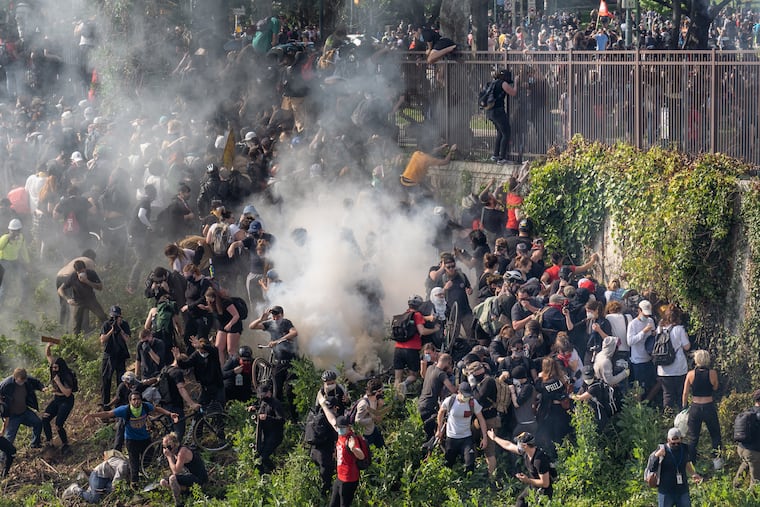Pa. State Police release dashcam video of Philly protesters on I-676. It does not show what might’ve prompted tear gas use.
The four hours of footage does not appear to show any acts of aggression toward police.

Pennsylvania State Police on Tuesday released dashcam video from a police SUV stationed on I-676 on June 1, when police fired tear gas on demonstrators marching on the highway against police brutality — and the footage does not appear to show any of the acts of aggression toward authorities that local and state officials said prompted their use of force.
The four hours of footage appear to have been recorded from one of several state police SUVs on the highway that day. The SUV with the dashcam does not appear to have been in the middle of the chaos as officers began spraying the gas at demonstrators, and the footage becomes mostly obstructed after about 50 minutes, when someone who can’t be seen on camera appears to cover much of the SUV’s windshield with spray paint or some other dark liquid.
Still, nothing in the minutes before or after that act appears to show protesters threatening the vehicle or anyone inside, or throwing rocks at police on scene — the behavior that both the State Police and city officials, including Mayor Jim Kenney and Commissioner Danielle Outlaw, have said caused the officers to resort to the use of gas and rubber bullets.
Ryan Tarkowski, a State Police spokesperson, said the videos were “the only videos of the June 1 incident on I-676 available from the Pennsylvania State Police.” He did not respond to questions about why the events depicted did not match explanations given earlier by officials, or why other police SUVs on the highway during the incident apparently did not have their dashcams rolling.
The agency is continuing to investigate its response, he said. State Police have previously said that their officers were likely the first to use tear gas, and that city police there followed suit.
City officials said this week that they will hire an outside consultant to evaluate their response to the protests, which began after police officers in Minneapolis killed George Floyd and lasted for days across different neighborhoods.
The Philadelphia Police Department has not released any videos of the event from any cameras its officers may have had on 676.
Deployment of the gas — particularly against demonstrators stuck on a steep embankment while trying to leave the roadway — caused outcry among citizens and elected officials, as did videos posted to social media of a Philadelphia police officer there ripping face masks off kneeling protesters to douse their faces with pepper spray.
Kenney and Outlaw said the use of tear gas was a “last resort” after protesters flooded an open highway, surrounded a state trooper’s car, and threw rocks at officers. Protesters, neutral observers, and journalists on scene reported seeing no acts on the level described by police, and footage from TV news helicopters showed neither the rock-throwing incident nor protesters harassing police vehicles.
Two videos shared on social media showed a protester spray-painting the windows of a police SUV while another wrote “PIGS” on its side. But neither video appears to show anyone throwing rocks or shaking the car.
The dashcam video begins without sound as the SUV holding the camera sits on the eastbound lanes of the highway, blocking an exit alongside several other State Police vehicles.
After about 42 minutes, the camera cuts to show the SUV being driven through traffic on the westbound lanes toward the exit for the Benjamin Franklin Parkway. An unidentified trooper can be heard yelling as cars struggle to pull off to the side to let his SUV through.
About 48 minutes into the video footage, the SUV stops in the middle of the highway, and a steadily growing crowd of protesters can be seen walking and skateboarding in the highway’s eastbound lanes and on its raised median. Some begin climbing into the westbound lanes, and someone covers most of the SUV’s windshield with the liquid.
Roughly an hour after the footage begins, the swell of the crowd appears to have moved past the SUV recording the action. Protesters can be heard screaming obscenities and protest chants like “Hand’s Up, Don’t Shoot” and “I Can’t Breathe” in the distance as troopers shout back: “Move, move. Let’s go!”
Then, firing begins.
Though the obstructed windshield makes it impossible to see what is being fired and by whom, the echo of distant shots rings out over and over again as faint screams can be heard in the background. The shots continue for nearly 10 minutes before the dashcam video suddenly cuts out and picks up again at a later point.
An officer reenters the car and begins speaking to others as he starts to drive. He stops after what appears to be a few feet to talk to other officers outside on the highway.
“Who rolled down the middle? Thanks,” the person says. “Whoever was in the f— middle with me, tell ‘em, thank you. I was f— until you guys showed up.”
Philadelphia Managing Director Brian Abernathy said days after the incident that a group of city officials including Abernathy, Kenney, Outlaw and several others approved use of “less than lethal munitions” on May 31, the day before the 676 demonstration, which allowed a commander on scene during the ongoing unrest to let officers use tear gas and rubber bullets.
Outlaw has declined to name the commander who decided to use tear gas on the highway.
Police have not said how many protesters were injured on 676, but many have said they had trouble breathing while trying to escape, suffered bruises after being hit by rubber bullets, and feared for their lives as panicked members of the crowd struggled to find a safe exit.